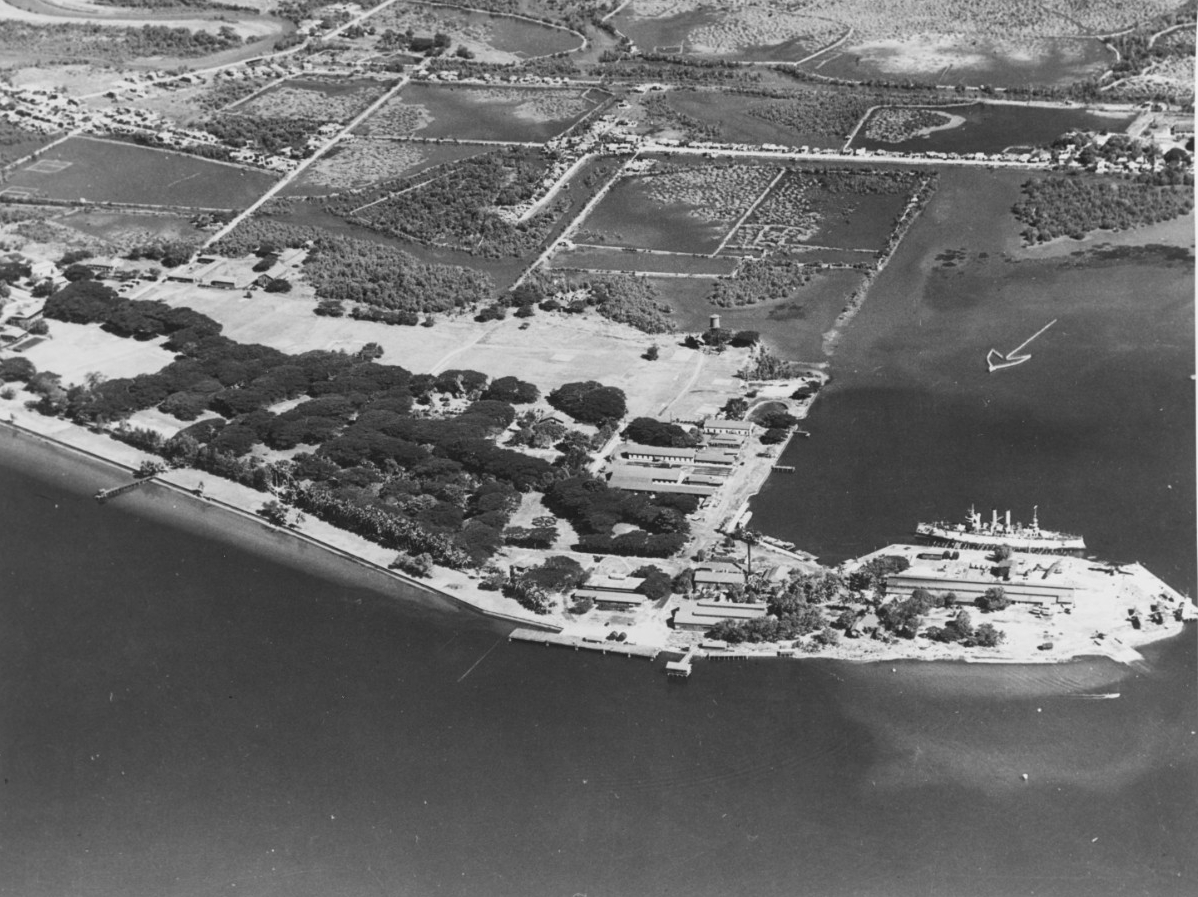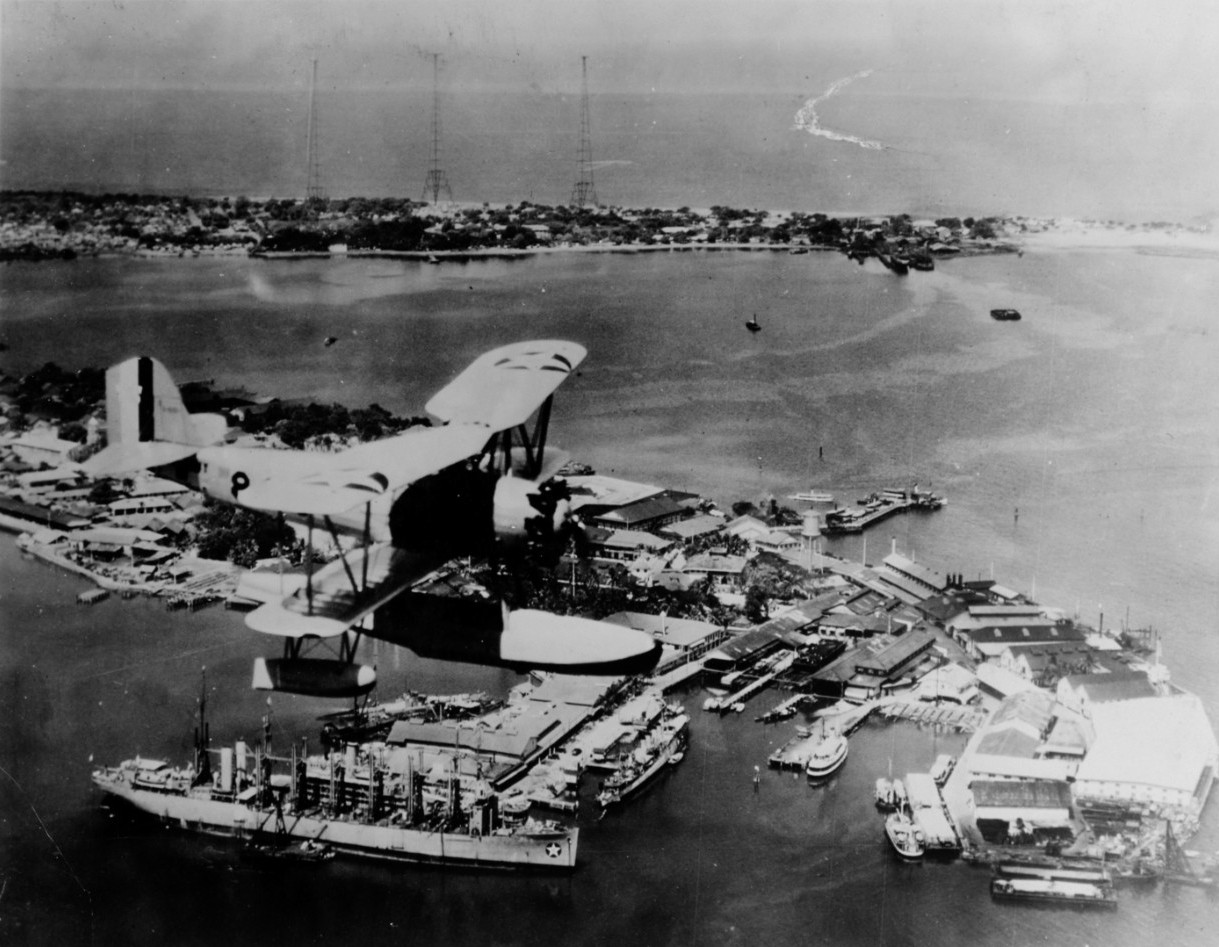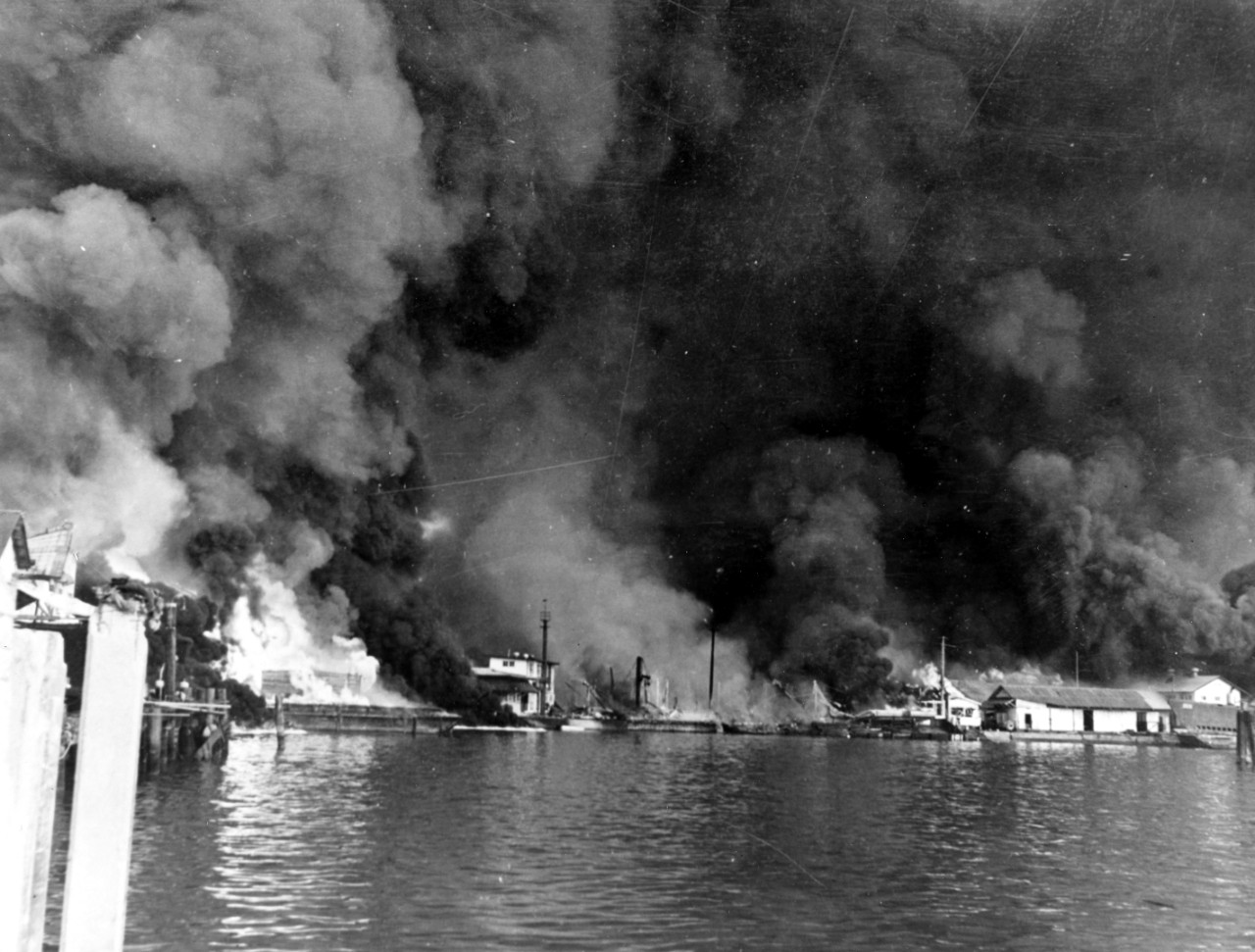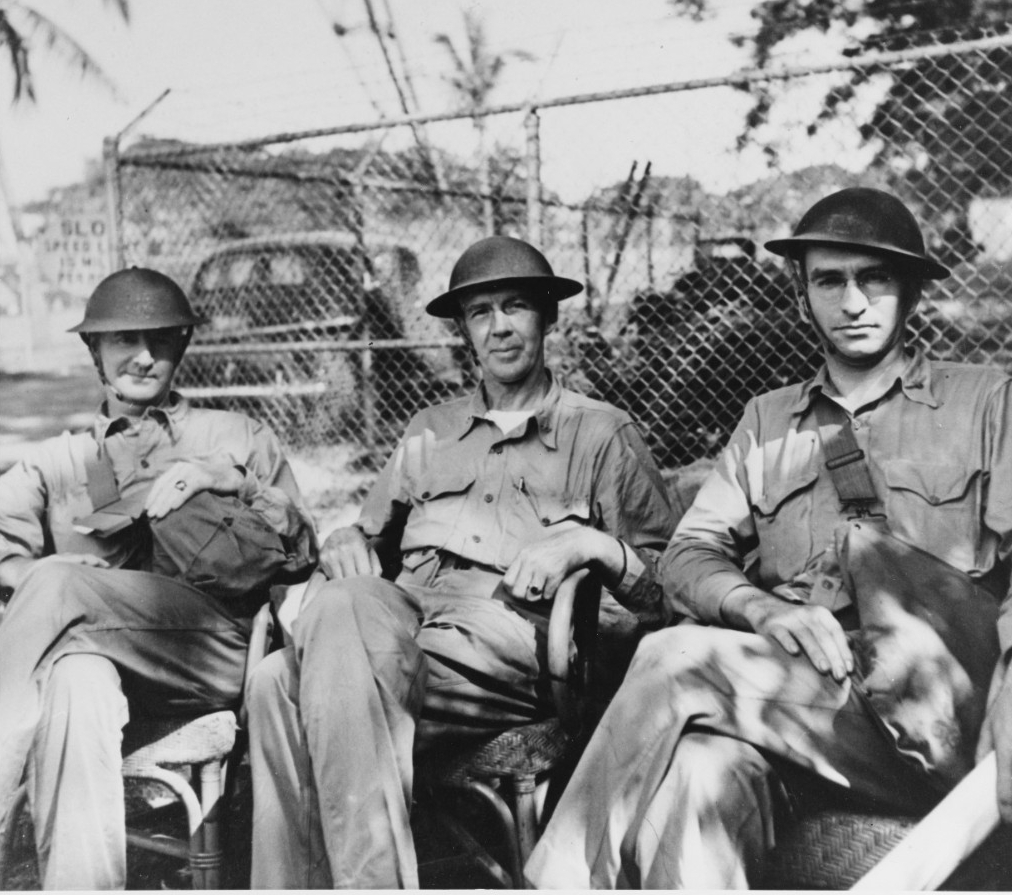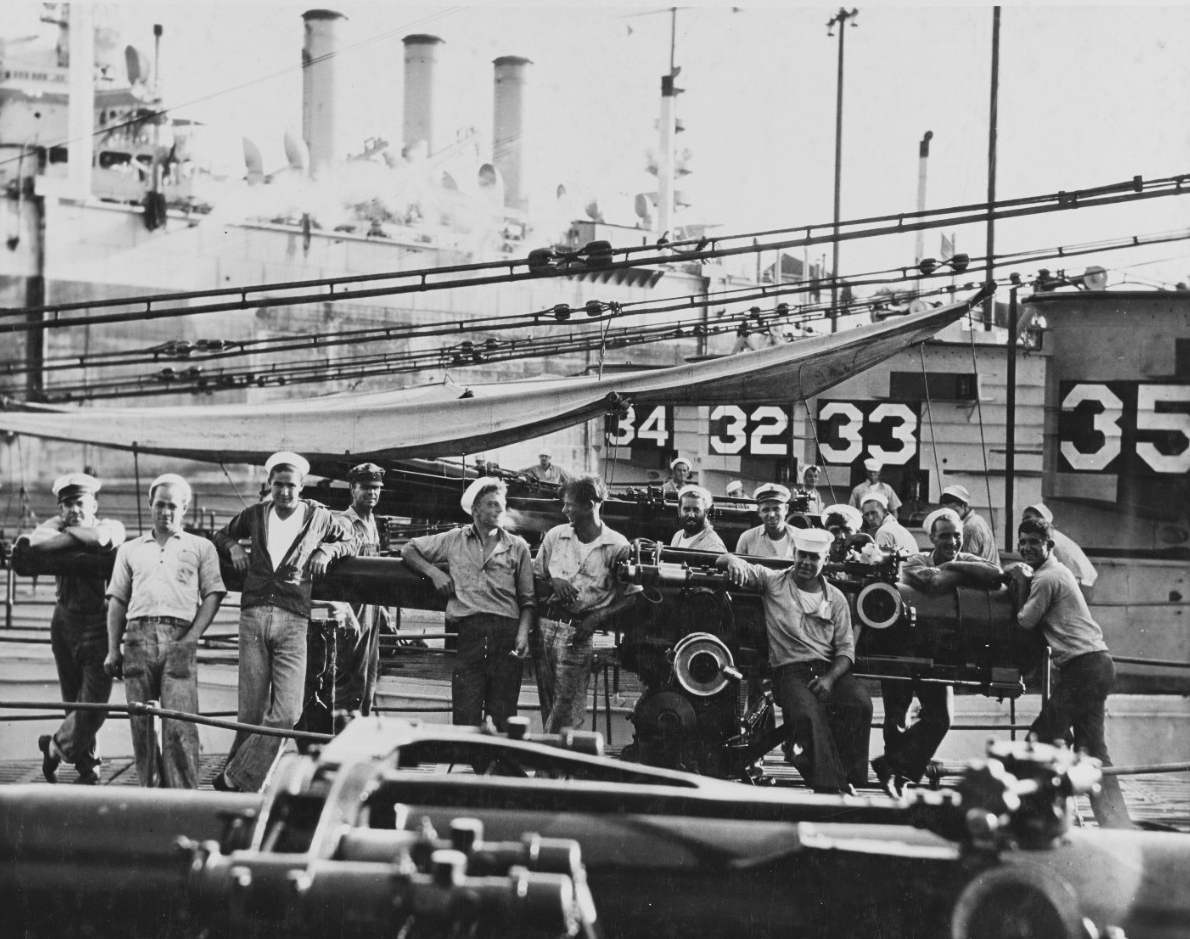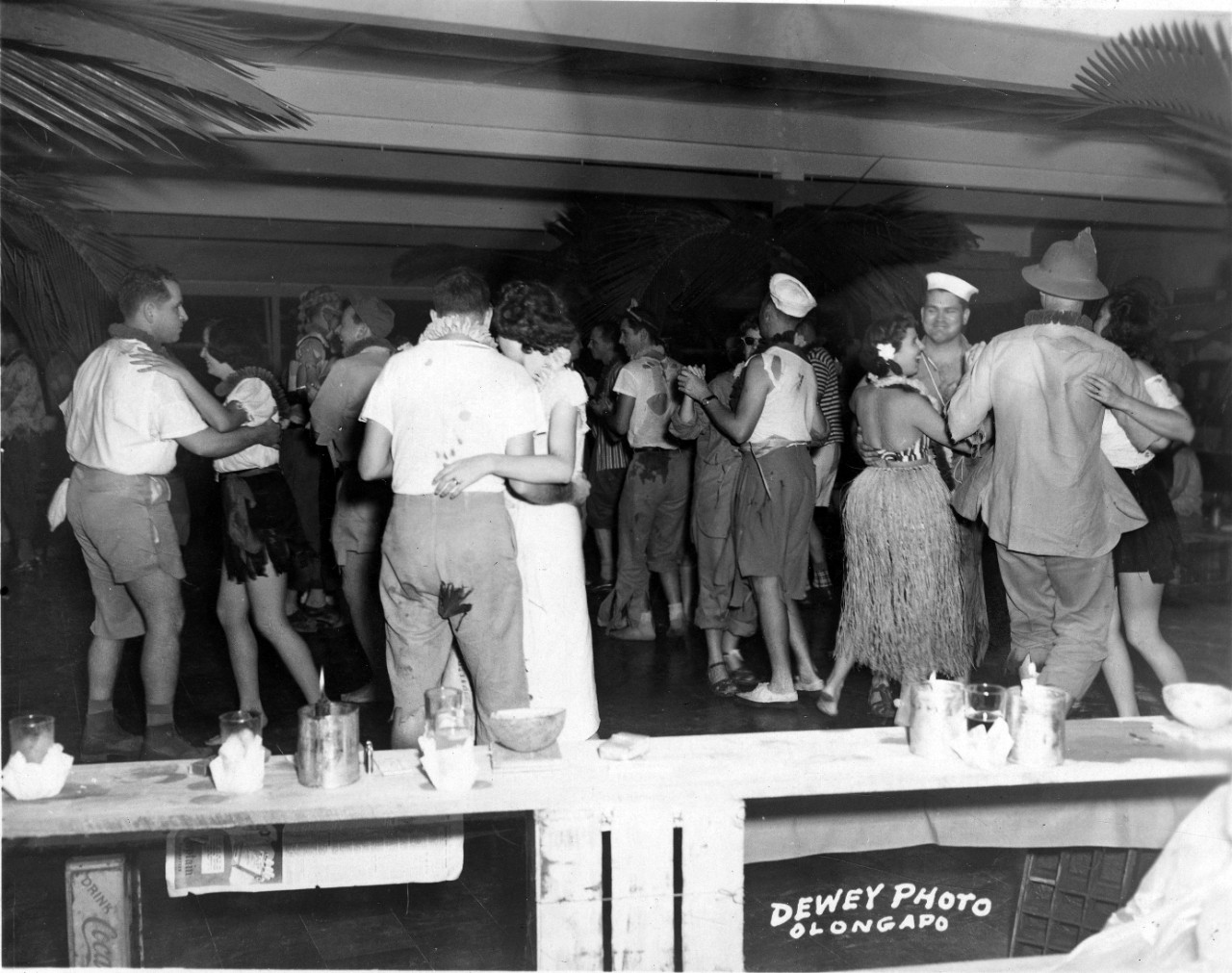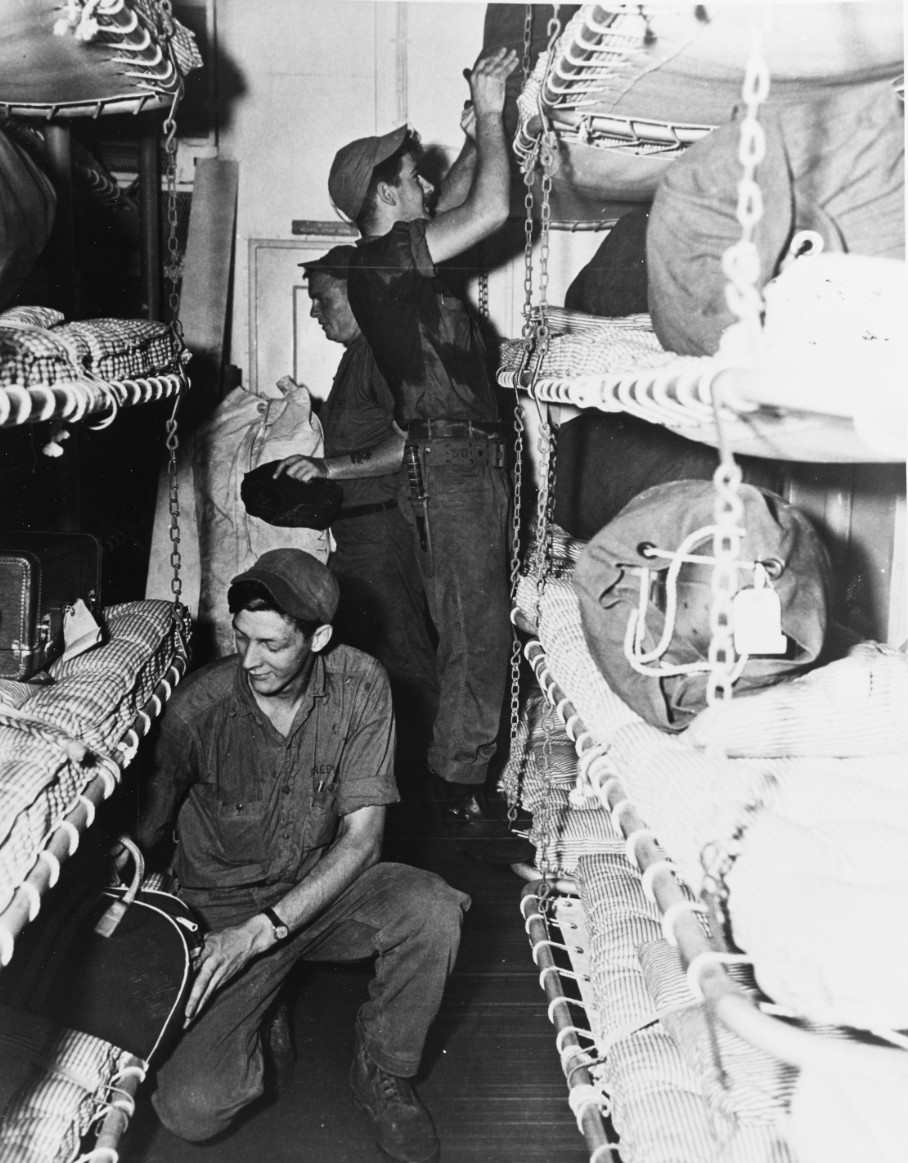Naval Bases in the Philippines
Situated on the eastern end of Manila Bay, Cavite Navy Yard operated from 1898 to 1948. The Spanish had begun occupying the area in the 16th century and had built several arsenals and forts to protect the city of Manila from attack. In the 19th century, they added shipbuilding facilities and a makeshift hospital at Sangley Point (which the Navy later expanded into Naval Hospital Cañacao). Prior to the U.S. Navy’s arrival, the shipyard served as the command center for all Spanish naval operations—the only arsenal and principal naval station in the Philippines.[1]
On 1 May 1898, Commodore George Dewey and his Asiatic Squadron seized the Philippines from Spain during the Battle of Manila Bay. On the morning of 2 May 1898, Dewey took possession of the former Spanish arsenal and shipyard at Cavite. The shipbuilding and repair facilities built by the Spanish were outdated and so primitive that the U.S. Navy had to modernize the yard for its own uses.[2] Cavite Navy Yard eventually became the chief repair and refueling base for the Asiatic Fleet. The U.S. Asiatic Fleet’s headquarters building was located nearby, on the Manila waterfront.
On 10 December 1898, the provisions of the Treaty of Paris officially ceded control of the Philippines to the United States. Two months later, Filipino nationalists seeking independence started an armed revolt against U.S. forces in Manila. Filipino combatants and U.S. forces fought for the next three years for control of the archipelago.
On 13 April 1899, three months after the start of the Philippine-American War, a battalion of Marines arrived to protect the Cavite Navy Yard from Filipino insurgents. Another battalion arrived in July, followed by a third in December. The third battalion was subsequently disbanded and the Marines absorbed into the first two battalions, which later became the 1st Marine Regiment. From 1900 to 1901, the Marines maintained law and order and guarded against insurgents. Throughout this time, Cavite Navy Yard remained free from insurrection.[3]
During the first two years of the Philippine-American War, U.S. Navy ships operated out of Cavite Navy Yard, carrying detachments of Marines and soldiers to various Philippine islands to fight insurgents. Navy ships also blockaded insurgent-held ports, shelled insurgent entrenchments, intercepted their trade, and maintained U.S. lines of communication.[4]
From 1898 to 1909, the Navy debated whether Cavite Navy Yard or Naval Station Subic Bay should become the primary base in the Philippines. The decision was important, as the base selected would need to be strongly fortified so it could be held against any attack until the arrival of the Navy’s battle fleet from the Atlantic.[5] Admiral Dewey and the other members of the General Board of the Navy selected Subic Bay as the site of the principle naval base since it had more potential for expansion and had a deep-water harbor. However, due to the fact that an Army garrison would need to protect whichever base was selected, the Army needed to be included in the decision. As a result, the Joint Army and Navy Board was created to develop a strategy for the expansion and defense of bases in the Philippines.[6]
In 1903, the board unanimously agreed to fortify a base at Subic Bay. This decision was not supported by U.S. Army Major General Leonard Wood, who commanded the Philippine Department, the primary Army command in the Philippines. Wood stated that all naval and military resources should be in Manila Bay, so that the Army could easily defend Manila, the commercial and political center of the islands.[7] Wood also favored Cavite Navy Yard since it was protected by the gun batteries at Corregidor and other harbor forts.[8] The Army and Navy continued to debate the location for the Navy’s main base until January 1908, when the board decided to accept that Subic Bay could not be adequately defended, and the main Navy base should be at Cavite.
However, President Theodore Roosevelt had decided by this time that the Philippines was not the place to locate the U.S. Navy’s major Pacific base. Frustrated by the vacillation of the Army and Navy and the meager appropriations offered by Congress, the President selected Pearl Harbor in Oahu, Hawaii, as the location for a major naval base in the Pacific. The plans to create a major naval base in the Philippines were shelved as the Navy’s focus shifted to Pearl Harbor.[9] The small ship-repair facilities at Cavite Navy Yard and Naval Station Subic Bay were retained, and both bases continued to operate to support the Asiatic Fleet.
The Five-Power Treaty, also known as the Washington Naval Treaty, signed on 6 February 1922, further reduced the Navy’s efforts to strengthen the defenses of the bases in the Philippines. This arms-limitation treaty between the United States, United Kingdom, Japan, France, and Italy set limits on the number and tonnage of naval warships under each country’s flag. It also prohibited the United States, United Kingdom, and Japan from expanding their military bases west of Hawaii.[10] No new equipment could be added at the shipyards—not even a new tool—unless the old tool was being scrapped.[11] No new fortifications could be added either. The treaty was to remain in effect until 31 December 1936, or beyond if none of the specified powers gave two-year notice of their desire to terminate it.
In the mid-1930s, Japan declared that they no longer felt bound by Washington Treaty. In 1936, the treaty expired and the Navy began to modernize Cavite Navy Yard. New machine tools were brought in, and additional workers hired; however, nothing was done to improve the base’s defenses.[12] By this time, the 50-acre yard was densely packed, with 146 buildings crowded closely together.[13] It included all the necessary machine and fabricating shops, an ammunition depot, and a fuel depot. There was no permanent dry dock, but small ships could be pulled out of the water on the small marine railway built there.[14]
By World War II, Cavite Navy Yard had become the largest and most important Navy base west of Hawaii. Approximately 400–500 American sailors were assigned to the yard with more than 8,000 Filipino civilians employed there.[15] The base continued to operate at a busy tempo as the Asiatic Fleet grew larger. Seabees had begun work on extending seaplane facilities at Sangley Point when the Japanese attacked the U.S. Pacific Fleet at Pearl Harbor, Hawaii on 7 December 1941.[16] Ten hours after the Pearl Harbor attack, Japanese aircraft bombed Clark Field and other Army airfields on the island of Luzon, Philippines.
Fires at Cavite Navy Yard resulting from the 10 December 1941 Japanese air raid. Barge No. 181 (visible in the right center) is loaded with burning torpedoes. The submarine whose bow is visible at the far right is probably USS Sealion (SS-195), which had been hit by bombs and settled by the stern (SC 130991).
At 1300 on 10 December 1941, a formation of enemy planes were spotted over Manila Bay, heading toward Cavite Navy Yard.[17] Flying at an elevation beyond the range of the yard’s antiaircraft guns, approximately 54 Japanese planes bombed Cavite Navy Yard for more than two hours.[18] Direct hits were made on several ships, submarines, tugs, and barges along Cavite’s waterfront, as well as the base power plant, dispensary, torpedo repair shop, supply office, warehouses, signal station, commissary, receiving station, barracks, and officers’ quarters. The only facility that was not directly hit was the naval ammunition depot. For the U.S. Navy, the attack brought “the worst damage inflicted on one of its shore installations by an enemy since the British burned the Washington Navy Yard in 1814.”[19]
During the attack, Marines from the 1st Separate Marine Battalion fired antiaircraft guns at the Japanese bombers, but their .50-caliber machineguns only reached 15,000 feet. The Japanese planes were flying at an elevation of 21,000–25,000 feet.[20]
Most of the ships moored at the Cavite Navy Yard pier on 10 December 1941 were in port to receive repairs and unable to get underway. With the threat of another attack imminent, ship and yard personnel worked furiously to complete repairs so the vessels could return to sea.[21]
Although several of the Asiatic Fleet’s ships were heavily damaged that day, only one submarine, Sealion (SS-195), and one ship, Bittern (AM-36), were lost. Sealion took two direct hits that killed four men and caused her to sink by stern. The submarine was later scuttled. Bittern was severely damaged by bomb fragments and fire. The minesweeper was towed to Fort Hughes in Manila Bay, then later moved to Mariveles Harbor on Bataan, before being scuttled 9 April 1942.[22]
The rest of the Asiatic Fleet ships in port that day were repaired and returned to duty. Some went on to support U.S. military personnel at Bataan and Corregidor, and elsewhere in the Philippines. Peary (DD-226), Pillsbury (DD-227), Whippoorwill (AM-35), and Otus (AS-20) steamed southward and participated in the Battle of Java Sea.
The impact to the yard’s buildings was more severe. As most of the buildings were constructed of wood, huge fires spread quickly across the overcrowded installation. Sailors and Marines assisted civilian firefighters in battling the raging fires. Marines also helped to evacuate personnel, weapons, and ammunition from areas threatened by exploding torpedo warheads.
Rear Admiral Francis W. Rockwell, the commander of the 16th Naval District, which was headquartered at the yard, was personally involved in rescue and salvage efforts that day. A member of Admiral Rockwell’s staff reported finding the admiral hatless, his shirt bloody from helping carry wounded men. The admiral and the senior officers on the yard were especially concerned with keeping the fires from getting too close to the ammunition depot. At 1800, a large fire re-ignited in the lumber yard, and was soon out of control, threatening nearby buildings. At 2100, Admiral Rockwell ordered the yard abandoned and all military personnel were moved off the base to the town of San Roque, Philippines.[23] Early in the morning of 11 December, Admiral Rockwell returned to the yard to inspect the damage. He reported to Admiral Thomas C. Hart, the commander in chief of the U.S. Asiatic Fleet, that the fires were completely out of control and the yard completely destroyed. They agreed to salvage as much as possible and to disperse the remaining torpedoes, mines, ammunition, and small arms to Corregidor Island and Mariveles Naval Section Base in Bataan, Philippines.[24]
After-action reports contained conflicting information on how many lives were lost that day. Unlike Pearl Harbor, there was no accounting of the names of the dead. The number of dead varied by source. A report issued by Admiral Rockwell stated that when U.S. Navy personnel entered the yard on 13 December, they found 122 bodies buried in a common grave. Another source listed 167 dead with 285 wounded. The U.S. Navy’s official list of casualties for the area of operations in December makes it easier to determine how many military personnel were lost. In December of 1941, total casualties for Navy organizations in the Philippines and Dutch East Indies were 10 officers and 97 enlisted personnel. If the numbers of casualties that occurred in other areas of the Philippines are subtracted from that number, it is estimated that 65–70 Navy personnel died during the bombing of Cavite Navy Yard.[25]
Fortunately, there were far fewer civilian casualties than there could have been. On the days prior to the attack, Admiral Rockwell and the commanding officer of the Cavite Navy Yard, Commander R. G. Deewall, took precautions by minimizing the number of civilian workers on base. Prior to the start of the war, the yard workforce included 8,000 civilian workers. On 10 December 1941, the only civilians allowed to work that day were those needed to complete vital repairs to yard vessels. The two senior officers also took precautions to protect the civilians in nearby towns. They worked with the Cavite City mayor to institute partial evacuations of his municipality and of San Roque, Philippines. Many of the civilians were able to evacuate to personnel shelters built before the start of the war.[26]
The Japanese launched another aerial attack on Sangley Point on 19 December 1941. In this raid, the Japanese blew up the remaining aviation fuel drums that had been left there (others had already been evacuated to Corregidor Island and Mariveles on Bataan). The raid also destroyed a radio tower and the power plant.[27] Fortunately, Naval Hospital Cañacao had already been abandoned. The hospital staff and patients relocated to Sternberg Army Hospital in Manila. On 3 January 1942, the Japanese took possession of Cavite Navy Yard and occupied the base through most of World War II.
Cavite Navy Yard was liberated by the U.S. Army in February 1945. In May 1945, the U.S. War Department and the U.S. Navy submitted a document for President Harry S. Truman and Philippine president Sergio Osmeña to sign that stated the U.S. Army and Navy would be permitted to retain U.S. military reservations in the Philippines, with the exception of Cavite Navy Yard.[28] The two presidents signed the joint document, which was later put into effect with the Military Base Agreement of 1947. Cavite Navy Yard continued to operate in a limited capacity until its closure. In June 1946, it consisted of only a small pontoon dry dock, a few lighters, light cranes, and a patrol boat. It functioned as a repair yard for small boats in the Manila Bay area until it was disestablished on 15 January 1948.[29]
U.S. Naval Station Sangley Point
Naval Station Sangley Point remained open after Cavite Navy Yard closed. Prior to World War II, Sangley Point had been part of the Cavite Navy Yard base, with a radio station, fuel storage, naval hospital, and a seaplane station. The seaplane station was established by Pan American Airways in the 1930s for its China route. After United States forces liberated the area from the Japanese in February 1945, the Seabees returned to the base to begin construction of aviation facilities in March 1945.[30] The 77th Naval Construction Battalion built a 5,000-foot runway and a terminal. They also extended seaplane facilities by building a ramp, hangar, warehouses, and pontoon slip.[31]
On 4 October 1945, the base became Naval Air Base Sangley Point. Two years later, on 27 February 1947, it was redesignated as Naval Air Station (NAS) Sangley Point. On 1 June 1950, its name changed again to Naval Station Sangley Point, though its function remained that of a naval air station.[32]
As the headquarters for U.S. naval forces in the Philippines, the base served an important diplomatic role in Southeast Asia. Many high-ranking military leaders from surrounding countries such as Indonesia, Malaysia, Thailand, Hong Kong (British), and Formosa/Taiwan utilized the base as a military port of entry into the Philippines. The base also played an active role in community affairs, supporting the Philippine American Community Action Program Project Handclasp. Its primary mission was to provide aviation support to the Seventh Fleet. It provided facilities to support regular operations of fleet reconnaissance, antisubmarine, transport, and utility aircraft and provided search-and-rescue facilities.[33]
Naval Station Sangley Point was the home base for flying boat squadrons of Patrol Wing 10, established in December 1940. Patrol Wing 10 conducted reconnaissance flights over Luzon, Philippines, to locate the build-up of the Japanese fleet.[34] After World War II, from 1950 until 1971, three patrol squadrons operated from the base, flying reconnaissance missions over the South China Sea and conducting antisubmarine operations.[35]
By 1954, the naval station employed 2,317 military and 1,484 civilians.[36] Aviation facilities included two seaplane ramps, five seaplane channels, an 8,000-foot runway, bombing range, fuel storage for 420,000 gallons, more than 30,000 square feet of aviation storage space, an all-weather station, air terminal, and nine seaplanes.
During the Vietnam War, the base supported air operations over the South China Sea.[37] Squadrons from the base supported reconnaissance patrol missions for Operation Market Time, flown from U.S. Naval Air Facility Cam Ranh Bay in Vietnam.
In 1969, Navy cutbacks resulted in patrol squadrons being transferred elsewhere and a reduction in surface ship operations. On 10 December 1969, the Navy announced that U.S. Naval Station Sangley Point would be returned to the Republic of the Philippines. On 1 July 1971 the base was placed in inactive status. The base hosted a disestablishment ceremony on 31 August 1971, which transferred the base to the Republic of the Philippines.
Crewmen pose with a 4-inch/50-caliber deck gun on board a S-Type submarine, March 1929. The submarines pictured are probably USS S-30 (SS-135) and USS S-31 (SS-136). Behind them are (from front to rear): USS S-35 (SS-140); USS S-33 (SS-138); USS S-32 (SS-137); and USS S-34 (SS-139). Photographed from USS Beaver (AS-5). In the background is USS Pittsburgh (CA-4) in the Dewey dry dock (NH 51830).
Naval Station Subic Bay, was located in the Zambales province, adjacent to the town of Olongapo, Philippines. Initial possession of the base occurred on 10 December 1899, when U.S. Marine Captain John T. “Handsome Jack” Myers led Marines ashore to “take charge of the Naval Station at Olongapo.”[38] At 0845 that morning, the first American flag flew above the former Spanish naval station. In 1905, Naval Station Subic Bay was officially established after President Theodore Roosevelt issued a general order allotting 16,250 acres for the base in Bataan and Zambales provinces.[39]
Like Cavite Navy Yard, Naval Station Subic Bay had shipyard facilities, including the floating dry dock Dewey (YFD-1). The 500-foot dry dock left Maryland on 28 December 1905 and arrived at Subic Bay on 10 July 1906. Four U.S. Navy ships towed the dry dock across the Atlantic, through the Mediterranean Sea and Suez Canal, across the Indian Ocean, and up through the China Sea to Luzon. [40]
Naval Station Subic Bay became an important repair facility for the Asiatic Fleet since Dewey was large enough to accommodate the fleet’s largest battleships. Cavite Navy Yard did not have docking facilities for larger battleships and its port was too shallow to accommodate a floating dry dock.
As noted above, the Five Power Naval Treaty forbade any increase of fortifications on Philippine bases. In 1922, all shipyard work and facilities at Naval Station Subic Bay—with the exception of repairs requiring the floating dry dock—were transferred to Cavite Navy Yard.
In the summer of 1941, as war with Japan seemed imminent, the Navy moved Dewey to Mariveles, in the well-protected Manila Bay.[41] The dry dock was scuttled on 8 April 1942 to prevent it from being used by the Japanese. The Japanese managed to raise it, but it was sunk later by American forces.
In early December 1941, the 4th Marine Regiment arrived at Naval Station Subic Bay, where they joined the 75-man detachment at the Marine Barracks on base. Their mission was to protect the naval station from the Japanese and prepare for field operations. On the morning of 12 December 1941, Japanese fighter aircraft attacked the base, strafing the PBY-4 Catalina boats moored on the water. All seven of the PBYs caught fire and eventually sank. Eleven aircrew were killed and four injured during the attack. Marines fired .30-caliber machine guns (their heaviest weapon) at the Japanese aircraft, but their fire did not damage any of the planes.[42]
Twenty-six Japanese aircraft flew over the base again the next day and dropped more bombs, but this aerial attack did not do much damage. Most of the base personnel had been evacuated months before, although there were some Marines wounded in the attack. Several bombs hit the city of Olongapo, killing 12 civilians and wounding 40.[43] Navy doctors and corpsmen provided medical aid to the wounded.
On 24 December 1941, the U.S. Army informed the U.S. Asiatic Fleet staff that the U.S. Army Forces in the Far East (USAFFE) headquarters would be withdrawing from Manila and the city would be declared an “open city” that day in order to minimize destruction and loss of civilian lives.[44] This meant that all U.S. forces would have to withdraw from the city. The USAFFE staff, led by U.S. Army General Douglas MacArthur, moved their headquarters to Corregidor.
Admiral Thomas C. Hart, the commander in chief of the U.S. Asiatic Fleet, told U.S. Marine Colonel Samuel L. Howard, the commander of the 4th Marine Regiment, that it was time for the Marines to be transferred to the Army’s tactical control. General MacArthur’s chief of staff, Lieutenant General Richard K. Sutherland, informed Howard that the 4th Marine Regiment would provide the primary beach defense on Corregidor. Howard relayed this information to Rear Admiral Francis W. Rockwell, the commander of the 16th Naval District, who was responsible for all Navy and Marine units in the Philippines. The admiral then ordered Howard to destroy anything of value on Naval Station Subic Bay before the Marines left.[45] On 26 December 1941, U.S. Marines destroyed most of the facilities on the base, with the exception of the Marine Barracks because it was located too close to Olongapo. The residents later set fire to the buildings in town before evacuating. The fire also consumed the Marine Barracks.
Four companies of Japanese Imperial Army soldiers and one company of kempetai (military police) arrived at Naval Station Subic Bay on 10 January 1942. For the next three years, the Japanese occupied the facility.[46]
In late January 1945, the U.S. Army liberated Naval Station Subic Bay from the Japanese. The Navy quickly began adding new facilities, to include a fleet training command, recreation facilities, fuel storage, naval supply depot, small boat repair unit, and a submarine base. Naval Station Subic Bay also included Naval Reservation Olongapo, with a population of approximately 15,000 people.[47]
As noted above, in July 1946, the Philippines gained independence from the United States. In 1947, the Republic of the Philippines and the United States signed the Military Bases Agreement, which allowed the U.S. Navy to retain all its military installations in the Philippines—with the exception of Cavite Navy Yard—under a 99-year lease. In the mid-1950s, Filipino politicians began negotiations with the United States to revise the 1947 Military Bases Agreement.[48] A portion of the negotiations centered on the rights of the Filipino citizens living in Olongapo.
The U.S. Navy had rebuilt the town of Olongapo after its destruction in World War II and made it part of the Naval Station Subic Bay. The commanding officer of Naval Station Subic Bay served as the chairman of the town council, school board, hospital board, and all other governing bodies.[49] The town’s Filipino residents wanted to be released from military control and administration. In December 1959, the U.S. Navy returned the 56,000-acre-town to the Republic of the Philippines.
In May 1949, the Seventh Fleet ships permanently left their homeport of Qingdao, China, and began operating from Naval Station Subic Bay and Naval Station Sangley Point.[50] By this time, there were six wharves and two piers, as well as 13 supplementary berths and 160 anchorages at the naval station port. In August 1964, when the Tonkin Gulf Incident officially brought the United States into the Vietnam War, Naval Station Subic Bay became the “supermarket and service station” of the Seventh Fleet.[51] The naval station became the source of food, fuel, and ammunition for U.S. Navy and allied ships operating off Vietnam.[52] About 60 percent of all servicing and repair work for the U.S. Seventh Fleet was completed in harbor support facilities at Naval Station Subic Bay.[53]
To sustain these operations, the workforce tripled; in 1953, there were 1,764 military personnel and 5,306 civilians employed on base. By 1968, the number increased to 16,600 civilians (16,000 Filipino and 600 American civil servants) and 5,000 U.S. military personnel. Filipino civilians worked on tugboats, yard oilers, and in other yard capacities to repair, refuel, resupply, and maintain U.S. Navy ships. In 1968, an average of 27 ships a day visited the naval station’s port. More than 5,400 sailors went on liberty each day in Olongapo in 1968.[54]
Olongapo was heavily populated with hostess bars, brothels, and businesses that catered to sailors and Marines arriving in port.[55] Venereal disease became a problem affecting 4 percent of naval personnel on liberty.[56] After 1970, the base tempo returned to pre-war levels, though it continued its main mission of providing supplies and training for Seventh Fleet ships.
On 15 June 1991, Mount Pinatubo, located 20 miles from the base, erupted with a force eight times greater than the Mount St. Helens eruption in 1980.[57] Naval Station Subic Bay was covered in a foot of ash. Heavy rains, volcanic earthquakes, and a typhoon followed the eruption. Ground tremors and the weight of wet ash caused 50 buildings in the Subic Bay area to topple. One Air Force dependent and a Filipino citizen were killed when the roof of George Dewey High School collapsed.[58] A total of 847 area residents died and 184 were injured. The volcano caused such damage to Clark Air Force Base that it closed completely.
Then–Secretary of Defense Dick Cheney authorized the evacuation of all non-essential military and civilian personnel and their dependents to protect them from further eruptions. Abraham Lincoln (CVN-72) and Midway (CV-41) transported 20,000 dependents and their pets (23 cats, 58 dogs, and one gecko) to Cebu, Philippines.[59] The dependents then boarded planes to Guam.
The 1947 Military Bases Agreement expired on 16 September 1991. After a series of negotiations between the Philippine and U.S. governments, the Philippine senate voted to against retaining U.S. military bases in the Philippines. On 24 November 1992, amphibious assault ship Belleau Wood (LHA-3) became the last ship to leave Naval Station Subic Bay.[60] On 24 November 1992, Naval Station Subic Bay officially closed.
Beginning in March 1992, the former naval station became the Subic Bay Freeport Zone, which is administered by the Subic Bay Metropolitan Authority. This government agency seeks to attract commercial investors in an effort to create jobs and industry.[61]
In 2014, U.S. Navy ships began utilizing the former naval base once again to deliver material and personnel for joint exercises and as a resupply port between port calls.[62] Merchant marine ships continue to use the port as well.
Seabees of Mobile Construction Battalion 3 (MCB 3) in their bunks aboard a barracks craft (APL), which would house them until huts were erected at the site of the new air station at Cubi Point, Philippines. Taken after their arrival at Subic Bay Naval Station, Philippines, 2 October 1951 (80-G-437390).
Navy Seabees arrived in 1951 to build a naval air station at Cubi Point, across the bay from Naval Station Subic Bay. The Seabees cut a small mountain in half and used the fill to build a 10,000-foot runway. They also constructed a pier for the Navy’s largest aircraft carriers. Seabees lived in a tent camp and worked in austere conditions battling heavy rains, insects, dust, and a water shortage. They excavated 23 million cubic yards of earth and used one million pounds of dynamite to quarry one million cubic yards of rock.[63] The project took five years and became the single largest earth-moving project ever undertaken by the U.S. Navy.[64]
Naval Air Station (NAS) Cubi Point was commissioned on 25 July 1956. Located on the edge of the Subic Bay reservation, it provided logistical support for Task Force 77—the Seventh Fleet’s carrier strike force.[65] The station had its own intermediate maintenance facility, which served as the maintenance and repair center for Seventh Fleet’s carrier-based aircraft. It included a pier to support the Navy’s largest aircraft carriers. Additionally, the U.S. Navy established the Jungle Environmental Survival Training School at NAS Cubi Point to prepare pilots and aircrew bound for Vietnam.
In 1971, when Naval Station Sangley Point closed, NAS Cubi Point absorbed much of the former base’s workload. Land-based photo reconnaissance, electronic surveillance, and airborne early warning aircraft squadrons operated from Cubi Point in support of naval air operations in Vietnam. The naval air station also became the primary source in the region for aircraft parts, equipment, and repairs. Most of the ordnance, fuel, mail, and other supplies for naval aviation units in Southeast Asia were processed through Cubi Point.
On 24 November 1992, Naval Air Station Cubi Point closed along with Naval Station Subic Bay. The former naval air station is now the site of Subic Bay International Airport.
—Wendy Arevalo, NHHC Communication and Outreach Division
____________
[1] Paolo E. Coletta and K. Jack Bauer, eds., United States Navy and Marine Corps Bases, Overseas (Westport, CT: Greenwood Press, 1985), 67–68.
[2] Richard J. Davis, “Brief History of the Cavite Navy Yard,” Society of Naval Architects and Marine Engineers (January 1943): 11–13.
[3] John H. Johnstone, A Brief History of the First Marines, (Washington, DC: Historical Branch, G-3 Division Headquarters, U.S. Marine Corps, 1962): 1–5.
[4] A. P. Niblack, “Operations of the Navy and Marine Corps in the Philippine Archepelago, 1898–1902,” Proceedings 30, no. 112 (October 1904): 4.
[5] William R. Braisted, “The Philippine Naval Base Problem, 1898–1900,” The Mississippi Valley Historical Review 41, no. 1 (1954), 21.
[6] William Emerson Berry, Jr. American Military Bases in the Philippines, Base Negotiations, and Philippine-American Relations: Past, Present, and Future (Ann Arbor, MI: University Microfilms, 1981), 22, 24.
[7] Braisted, “The Philippine Naval Base,” 28.
[8] John Gordon, Fighting for MacArthur: The Navy and Marine Corps’ Desperate Defense of the Philippines (Annapolis, MD: Naval Institute Press, 2001), 7–8.
[9] Berry, American Military Bases, 33.
[10] Coletta, United States Navy Bases, 67
[11] Davis, “Brief History of Cavite,” 12.
[12] Coletta, United States Navy Bases, 67.
[13] Davis, “Brief History of Cavite,” 12.
[14] Greg H. Williams, The Last Days of the United States Asiatic Fleet: The Fates of the Ships and Those Aboard, December 8, 1941–February 5, 1942 (Jefferson, NC: McFarland Incorporated, 2018), 49–50.
[15] Gordon, Fighting for MacArthur, 5.
[16] Building the Navy's Bases in World War II: History of the Bureau of Yards and Docks and the Civil Engineer Corps, 1940–1946. Washington, DC: Government Printing Office (GPO), 1947), 391–93. Google Books.
[17] Gordon, Fighting for MacArthur, 49.
[18] Samuel E. Morison, History of United States Naval Operations in World War II, Vol. III—The Rising Sun in the Pacific, 1931–April 1942. Boston: Little, Brown and Company, 1950.
[19] Gordon, Fighting for MacArthur, 41.
[20] J. Michael Miller, From Shanghai to Corregidor: Marines in the Defense of the Philippines (Washington, DC: Marine Corps Historical Center, 1997), 7.
[21] Gordon, Fighting for MacArthur, 48.
[22] Gordon, Fighting for MacArthur, 63.
[23] Gordon, Fighting for MacArthur, 58–59.
[24] Morison, Rising Sun, 172.
[25] Gordon, Fighting for MacArthur, 60–61.
[26] Gordon, Fighting for MacArthur, 42, 61
[27] Honolulu Advertiser (Honolulu, HI), Oct 27, 1942; Gordon, Fighting for MacArthur, 76.
[28] Berry, American Military Bases, 132.
[29] Coletta, United States Navy Bases, 68.
[30] Appendix 6 - Patrol Squadron Shore Establishments (navy.mil), 766.
[31] Building the Navy's Bases in World War II: History of the Bureau of Yards and Docks and the Civil Engineer Corps, 1940-1946. Washington, DC: U.S. Government Printing Office, 1947), 391–93. Google Books
[32] Appendix 6 - Patrol Squadron Shore Establishments (navy.mil), 766.
[33] Coletta, United States Navy Bases, 298.
[34] “Command History,” Patrol and Reconnaissance Wing 10, accessed 14 January 2022.
[35] Selig S. Harrison, “Philippines Asks Return of Air Base Leased by U.S. Navy in Manila Bay,” Washington Post, 27 March 1967.
[36] Coletta, United States Navy Bases, 298.
[37] Edward J. Marolda, Ready Seapower: A History of the U.S. Seventh Fleet, (Washington, DC: NHHC, 2012), 71
[38] Gerald R. Anderson, Subic Bay: From Magellan to Pinatubo (Dagupan City, PI: Great Books, 2006), 97.
[39] Berry, American Military Bases, 25.
[40] Davis, “Brief History of Cavite,” 11.
[41] Morison, History of United States, 155.
[42] Gordon, Fighting for MacArthur, 16, 71.
[43] Gordon, Fighting for MacArthur, 72.
[44]Gordon, Fighting for MacArthur, 89.
[45] Gordon, Fighting for MacArthur, 90–91.
[47] Coletta, United States Navy Bases, 310.
[48] Joseph W. Dodd, Criminal Jurisdiction Under the United States-Philippine Military Bases Agreement: A Study in Conjurisdictional Law (Netherlands: Springer Netherlands, 2012), 91–92.
[49] Anderson, Subic Bay, 130.
[50] Marolda, Ready Seapower, 19.
[51] Anderson, Subic Bay, 97, 141.
[52] Anderson, Subic Bay, 141.
[53] James A. Gregor, “The Key Role of U.S. Bases in the Philippines,” Asian Studies Backgrounder, no. 7 (January 1984): 5.
[54] Coletta, United States Navy Bases, 312.
[55] Ralph Jennings, “U.S. Navy Edges Back to Subic Bay in Philippines—Under New Rules,” Christian Science Monitor, 12 November 2015.
[56] Coletta, United States Navy Bases, 311.
[57] Anderson, Subic Bay, 169.
[58] Marolda, Ready Seapower, 110; Anderson, Subic Bay, 169.
[59] Karl Zingheim, “Midway’s Operation Fiery Vigil,” Karl’s Korner, USS Midway Museum, 25 February 2019.
[60] Anderson, Subic Bay, 181.
[61] Floyd Whaley, “Shadows of an Old Military Base,” New York Times, 26 April 2013.
[62] Jennings, “U.S. Navy Edges Back.”
[63] Cubi Point: They Moved a Mountain,” U.S. Navy Seabee Museum, NHHC, last modified 26 February 2020.
[64] “Cubi Point,” Naval History and Heritage Command.
[65] Spencer C. Tucker, ed., The Encyclopedia of the Vietnam War: A Political, Social and Military History (Santa Barbara, CA: ABC-CLIO, LLC, 1997), 246–8.

